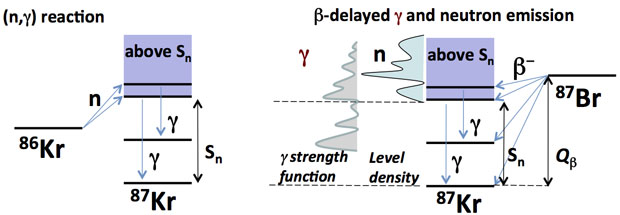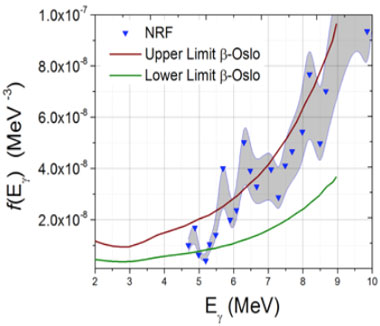Jutta Escher (15-ERD-069)
Abstract
Neutron-induced reactions on short-lived fission products play a major role in the transmutation of elements in astrophysical bodies, nuclear explosions, and nuclear reactors. We propose a theoretical and experimental effort to determine the feasibility of obtaining neutron-capture cross sections for reactions on isotopes far from stability ("exotic nuclei") by taking advantage of data collected on the reverse process of neutron emission following beta decay. Predictions of cross sections for nuclei away from stability rely on extrapolations, and become increasingly uncertain. These cross sections are needed to understand the synthesis of heavy elements by supernova nucleosynthesis (creation of new atomic nuclei), and to model fission-fragment burnup relevant to radiochemistry. Our project addresses the need for a reliable, data-guided theory by seizing upon a unique opportunity to gain access to high-quality nuclear data well ahead of the scheduled operation of the DOE's Facility for Rare Isotope Beams at Michigan State University in East Lansing, and by establishing the connection between this data and capture cross sections. We explored different approaches for carrying out the measurements and data analyses and determined the most promising path forward. We also initiated new collaborations with experimentalists and theorists and developed successful proposals for new experiments.
Background and Research Objectives
Of the thousands of nuclei that exist, only a small fraction can currently be studied experimentally and described reasonably well by theory, namely those in and near the “valley of stability.” Measuring and describing nuclei far from stability is, however, of great importance for nuclear astrophysics and Livermore applications. For instance, the tin region where atomic number ranges from approximately 130 to 140 is crucial for understanding the production of the elements from iron to uranium that we observe today. Half of these isotopes are believed to be produced through the rapid-neutron capture process (r-process). The capture cross sections significantly affect the isotopic abundance patterns predicted by r-process models, and need to be known to draw conclusions about stellar evolution and nucleosynthesis.1 Uncovering the origin of the heavy elements has been identified by the Nuclear Science Advisory Committee as one of the most important overarching questions in nuclear science.2 Capture cross sections on nearby neutron-rich fission fragments are also crucial for LLNL’s radiochemistry program.
At the valley of stability, where statistical, "compound" processes dominate capture reactions, direct measurements can be used to constrain calculations. Predictions of cross sections for nuclei away from stability, however, rely on extrapolations and become increasingly uncertain. Level densities, and thus the number of nuclear states involved in a reaction, decrease with distance from stability. The neutron capture cross sections for tin isotopes have been estimated to drop by 2 to 3 orders of magnitude when moving from stability, where the atomic number is 126, to the astrophysically relevant region, where the atomic number ranges from 130 to 140 and the predictions for compound cross sections differ by more than an order of magnitude. Moreover, additional, non-compound processes can contribute. Direct measurements to constrain the calculations are not possible in this region. This example is representative of our current knowledge of capture reactions involving nuclei far from stability.
The need for a better understanding of exotic nuclei is widely recognized. The nuclear science community is in the process of constructing the Facility for Rare Isotope Beams, a $730M DOE Office of Science user facility being constructed at Michigan State University in East Lansing, which will be dedicated to the study of such nuclei. Unfortunately, this facility will not be able to produce the requisite beams for about ten more years. However, for neutron capture on short-lived fission fragments, this shortcoming can potentially be addressed by measuring the reverse process of beta-delayed neutron emission.
Our objective was to determine the feasibility of obtaining capture cross sections for exotic nuclei by employing an innovative indirect approach that makes use of beta-decay data obtained from radioactive nuclei. We focused on isotopes close to stability, because benchmark results are available for these systems.
Scientific Approach and Accomplishments
Our work focused on an innovative method for constraining theoretical cross section calculations with beta-decay data from exotic nuclei. Radioactive beams are now available at multiple facilities, such as Argonne National Laboratory and the National Superconducting Cyclotron Laboratory at Michigan State University. The Facility for Rare Isotope Beams will provide more intense beams of isotopes farther from stability. The availability of these exotic beams make it possible to produce important isotopes via beta decay and study the subsequent competition between neutron and gamma-ray emission. It is this competition that plays a significant role in the calculation of capture cross sections. Figure 1 illustrates the approach for 86krypton(n,gamma): Experimentally, a (known) subset of the neutron-unbound states in krypton-87 relevant to capture is produced via Gamow–Teller beta decay of the precursor nucleus bromine-87, and the subsequent decay by neutron and gamma emission is measured.
Recently developed trapping techniques, which make it possible to studying beta-delayed neutron emission by measuring nuclear recoils in an ion trap, can be used to measure neutron spectra with high precision, efficiency, and signal-to-noise ratio.3 Complementary experiments, which focus on beta-delayed gamma emission have been carried out by groups at the University of Jyvaskyla in Finland and at the National Superconducting Cyclotron Laboratory.4,5 Various analysis techniques can be used to obtain the relative contributions of the neutron and gamma-ray emission and other quantities that are relevant to the calculation of capture cross sections.
We investigated several possible procedures for extracting cross section constraints from the data and determined challenges and limitations of each measurement and analysis method, as well as the most promising path forward. In most cases, we found it is necessary to obtain information on how the intermediate nucleus is populated by beta decay. We initiated a collaboration with the French Alternative Energies and Atomic Energy Commission in Bruyères-le-Châtel, which provided us with microscopic predictions for beta-decay strength functions for several isotopes of interest. These are initial results involving state-of-the-art quasiparticle random-phase approximation calculations with the finite-range Gogny force. The beta-decay strength functions can be used as input for statistical calculation of the subsequent emission of neutrons and gamma rays. A comparison with data from beta-decay measurements is then expected to yield the necessary constraints on quantities that enter capture calculations. We obtained experimental results for the beta-delayed neutron and gamma-ray emission for the bromine-87 → krypton-87 case from the recent literature.4 Our calculations and comparisons led us to conclude that improvements in the predictions of the beta-decay strength functions are required, and that the available data cannot be explained within commonly used descriptions of statistical nuclear decay. Because experimental problems cannot be ruled out in this case, we developed a further test of the experimental approach. Our collaboration, consisting of scientists from LLNL, Michigan State University, and the University of Oslo, was awarded the full request of 173 hours of beam time at the National Superconducting Cyclotron Laboratory.
The planned experiment will not only shed light on the data discussed above, but also further develop an alternative method to analyze the beta-decay data: The so-called beta-Oslo method aims at extracting level densities and gamma-ray strength functions from measured beta-delayed gamma-ray data—both quantities are crucial input for capture cross section calculations. A recently published proof-of-principle measurement applied the method to the germanium-75(n,gamma) cross section.5 The results given in the publication are very encouraging, even though the analysis used employed various approximations and relied on auxiliary data from other sources.
To better assess the promise of the beta-Oslo approach, we compared the gamma-ray strength function obtained in this approach with a more direct measurement of this quantity. To this end, we obtained the photoabsorption cross section on the stable germanium-76 nucleus from a recent nuclear resonance fluorescence experiment at the Triangle Universities Nuclear Laboratory in Durham, North Carolina. From this data, we extracted the gamma-ray strength function and obtained a stringent test for the beta-Oslo method. We found that, even though the nuclear resonance fluorescence experiment yields a gamma-ray strength function that has more structure and is slightly larger than the result from the beta-Oslo method, both approaches give similar results (see Figure 2).
Based on our calculations and analyses of existing experimental data, we conclude that at present the beta-Oslo method is the most promising approach for obtaining capture cross section constraints from beta-decay data. We have also pursued avenues to improve the theoretical framework needed to plan and apply such indirect methods for obtaining cross sections on unstable isotopes, as well as for carrying out direct calculations of neutron capture cross-sections. To this end, we collaborated with nuclear physicists from North Carolina State University, Ohio University in Athens, and Louisiana State University in Baton Rouge for a five-week program at the Institute for Nuclear Theory at the University of Washington.
Impact on Mission
The goal of this project was to develop a new approach to reliably determine, for the first time, capture cross sections for isotopes far from stability. As a result of our work, we were able to assess different avenues for using beta-delayed neutron and gamma-ray measurements to obtain constraints on calculated neutron capture cross sections. Such cross sections are needed to increase the fidelity of the physics models that calculate fission-product burnup and are used to understand supernovae nucleosynthesis, supporting the Laboratory's core competency of nuclear, chemical, and isotopic science and technology relevant to operation of nuclear weapons, and thus important for stockpile stewardship science efforts.
Conclusion
We examined the feasibility of a new technique to indirectly determine neutron capture cross sections on short-lived isotopes. Indirect approaches will be crucial for determining (n,gamma) cross sections of interest for nucleosynthesis in the region where the atomic number ranges from 130 to 140, and more broadly for neutron capture on exotic nuclei. We have determined the limitations of several approaches and formulated recommendations for proceeding towards indirect measurements of cross sections relevant to astrophysics and laboratory applications. Our work brought into focus the promises and limitations of the approaches under consideration and identified the most promising path forward, with results helping to guide the growth of the Laboratory’s beta-decay program. We have initiated experimental and theory collaboration with nuclear physicists at other laboratories and universities, and plan to conduct experiments at the National Superconducting Cyclotron Laboratory to pursue the most promising path forward, along with a five-week program at the Institute for Nuclear Theory in Seattle to advance theory for nuclear reactions across the isotopic chart. These efforts comprise the next logical steps for developing this indirect approach for obtaining important cross sections involving exotic nuclei.
References
- Surman et al., "Neutron capture rates near A = 130 that effect a global change to the r-process abundance distribution." Phys. Rev. C 79(4), 045809 (2009). https://doi.org/10.1103/PhysRevC.79.045809
- The DOE/NSF Nuclear Science Advisory Committee, The frontiers of nuclear science: A long-range plan. (2007)
- Spyrou, A., et al., "Novel technique for constraining r-process (n,γ) reaction rates." Phys. Rev. Lett. 113(23), 232502 (2014). https://doi.org/10.1103/PhysRevLett.113.232502
- Yee. R. M., et al., "β-Delayed neutron spectroscopy using trapped radioactive ions." Phys. Rev. Lett. 110(9), 092501 (2013). https://doi.org/10.1103/PhysRevLett.110.092501
- Algora A., et al., "Total absorption study of beta decays relevant for nuclear applications and nuclear structure." Nucl. Data Sheet. 120, 12 (2014). https://doi.org/10.1016/j.nds.2014.06.129
Publications and Presentations
- Escher, J. E., et al., Compound-nuclear reactions with unstable isotopes: Constraining theory through innovative experimental approaches. (2015). LLNL-PRES-678475.
- Tonchev, A., et al., Measuring neutron capture cross sections on s-process radioactive nuclei. (2015). LLNL-PRES-670315.
- Tonchev, A. P., et al., Neutron capture cross sections for radioactive nuclei. (2015). LLNL-PRES-678627.







